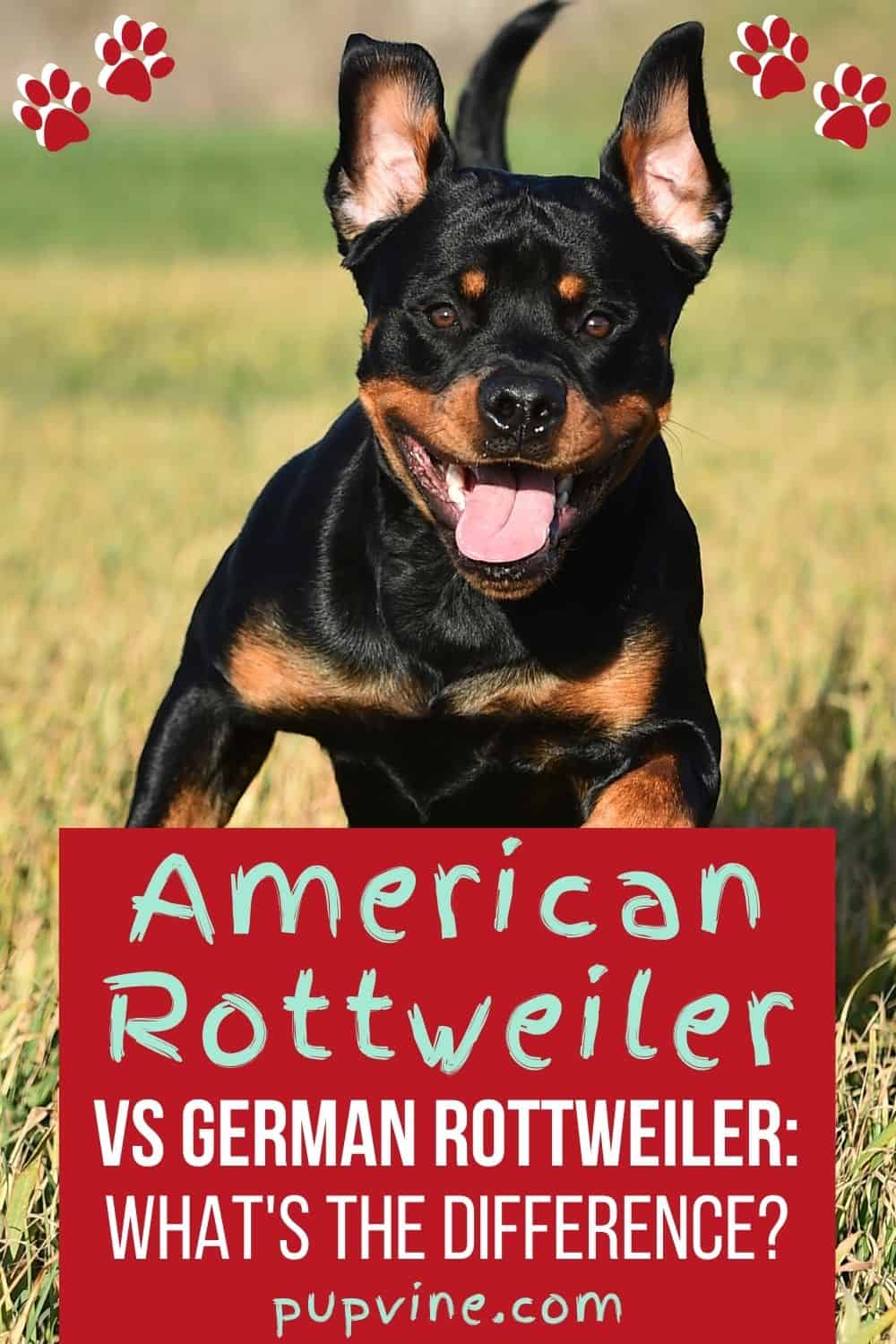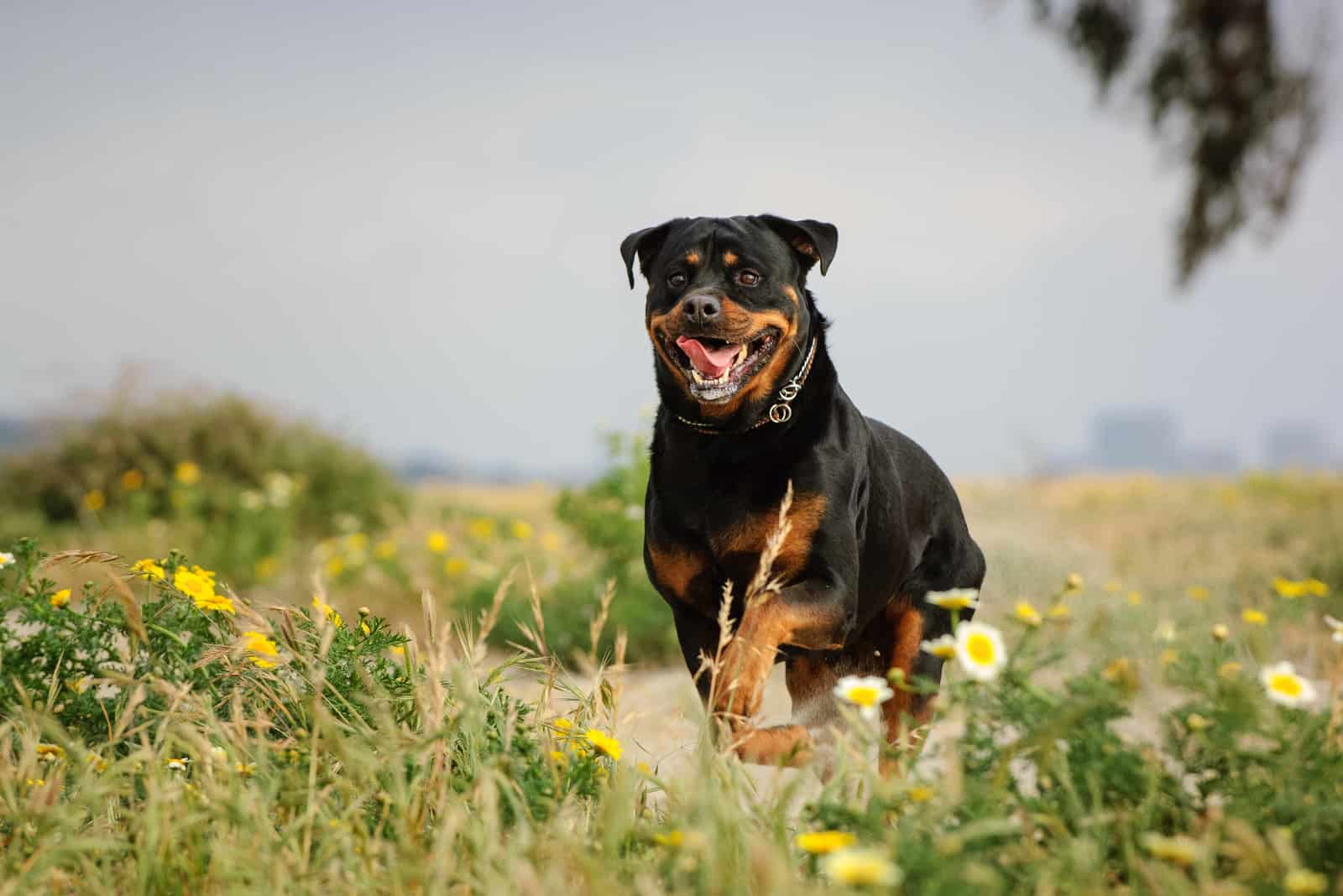Are you aware that there is more than one type of Rottweiler? It’s often debated whether the differences between the American and German types are substantial enough to view them as separate variations of the breed.
However, most people do consider them as such, so let’s explore why.
It all comes down to nationality. If your puppy was born in America, he’s an American Rottweiler, and if he was born in Germany, he’s a German Rotty; it’s as simple as that.
Even a Rottweiler puppy that has a German bloodline, but was born in the USA, would still be considered an American.
All the other dissimilarities between them, either in appearance or in character, are the result of these countries using different dog breed standards.
The differences among these dogs are so slight that the largest world canine organization, the FCI (Fédération Cynologique Internationale), doesn’t even recognize the regional prefixes.
According to them, there is only one kind of Rottweiler, the one that fits their own standards regardless of where they come from.
What exactly are those differences? Let’s find out!
A short history of the breed
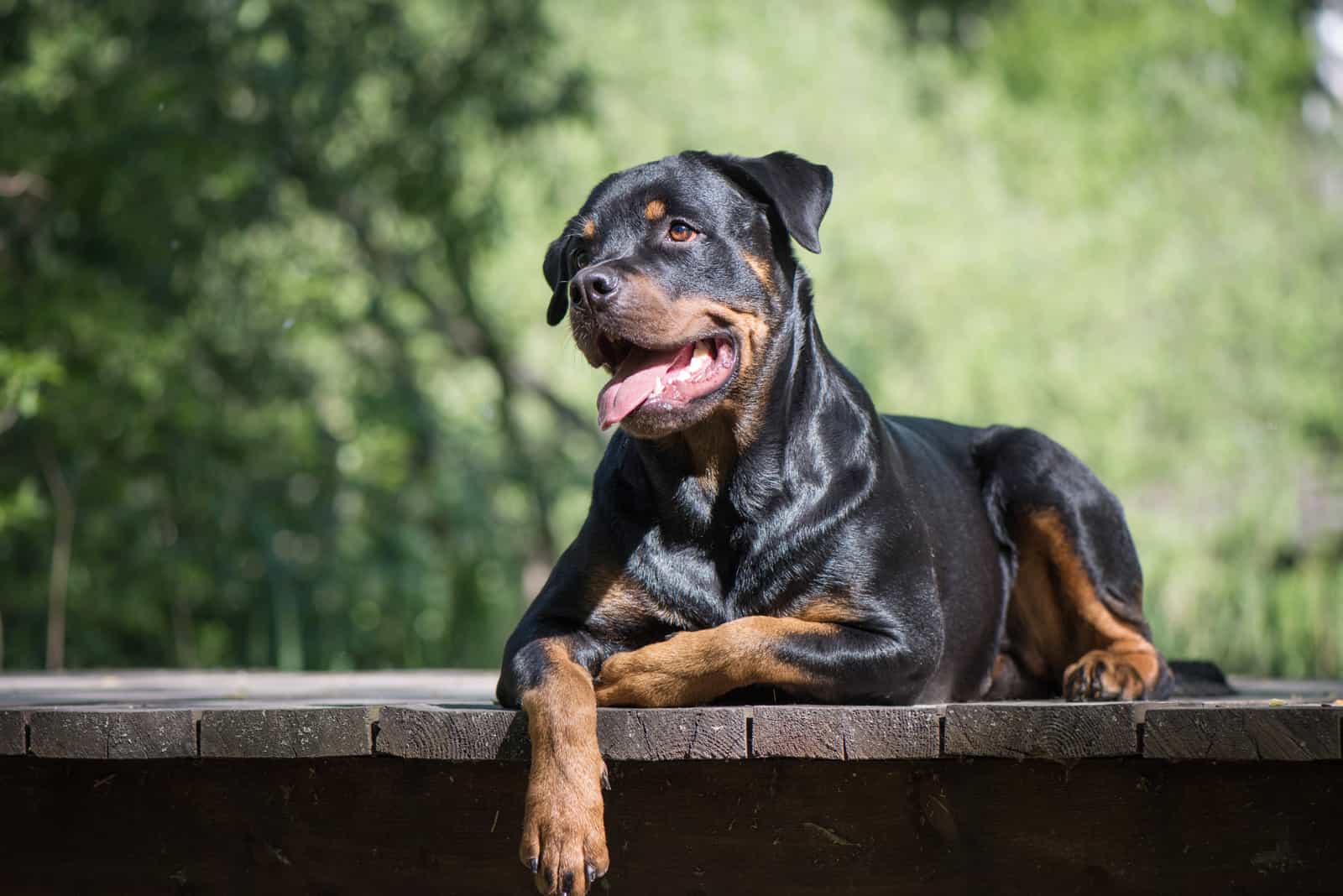
Dating back to ancient times, the Rottweiler is one of the oldest dog breeds in the world.
The Roman army was in need of strong, tenacious dogs that would be able to accompany and guard them in their conquests and drive cattle across the European continent.
This led to the creation of Roman drover dogs, by using the Asian mastiff types as breeding stock. These drover dogs are distant ancestors of the Rottweilers we know today.
When traveling to the northern territories of the empire where they often fought with ”the barbarians hoards” as they called the Germanic armies, Roman legions brought the drovers with them.
After the fall of the Roman empire, the legions retreated, but their dogs stayed in this region, which today, is the south of Germany.
In the cattle region of Rottweil, these hard-working herding dogs were quite welcome. Here, they mated with native dogs, which resulted in the creation of the first Rottweilers, later named after the region itself.
They were first known as Rottweiler Metzgerhund, meaning the Butcher’s Dog of Rottweil, which tells us how valued their cattle-herding skills were.
When their career in livestock ended, they proudly took up other jobs such as guarding property, doing demanding police work, or helping humans in search and rescue missions.
The first breed standard for these dogs was set in 1901 when the International Club for Leonberger and Rottweiler Dogs in Germany produced the first standard Rottweiler.
From then on, the Rotty’s popularity started to rise and they spread across the globe.
That’s how these German puppies came to America to eventually naturalize and become one of the most popular dog breeds in the USA.
The American Kennel Club officially recognized the breed in 1931, making the breed requirements similar to those in Germany at the time. Later revisions of the standards made the distinction between the German and the American Rotties possible.
Rottweiler–the workaholic
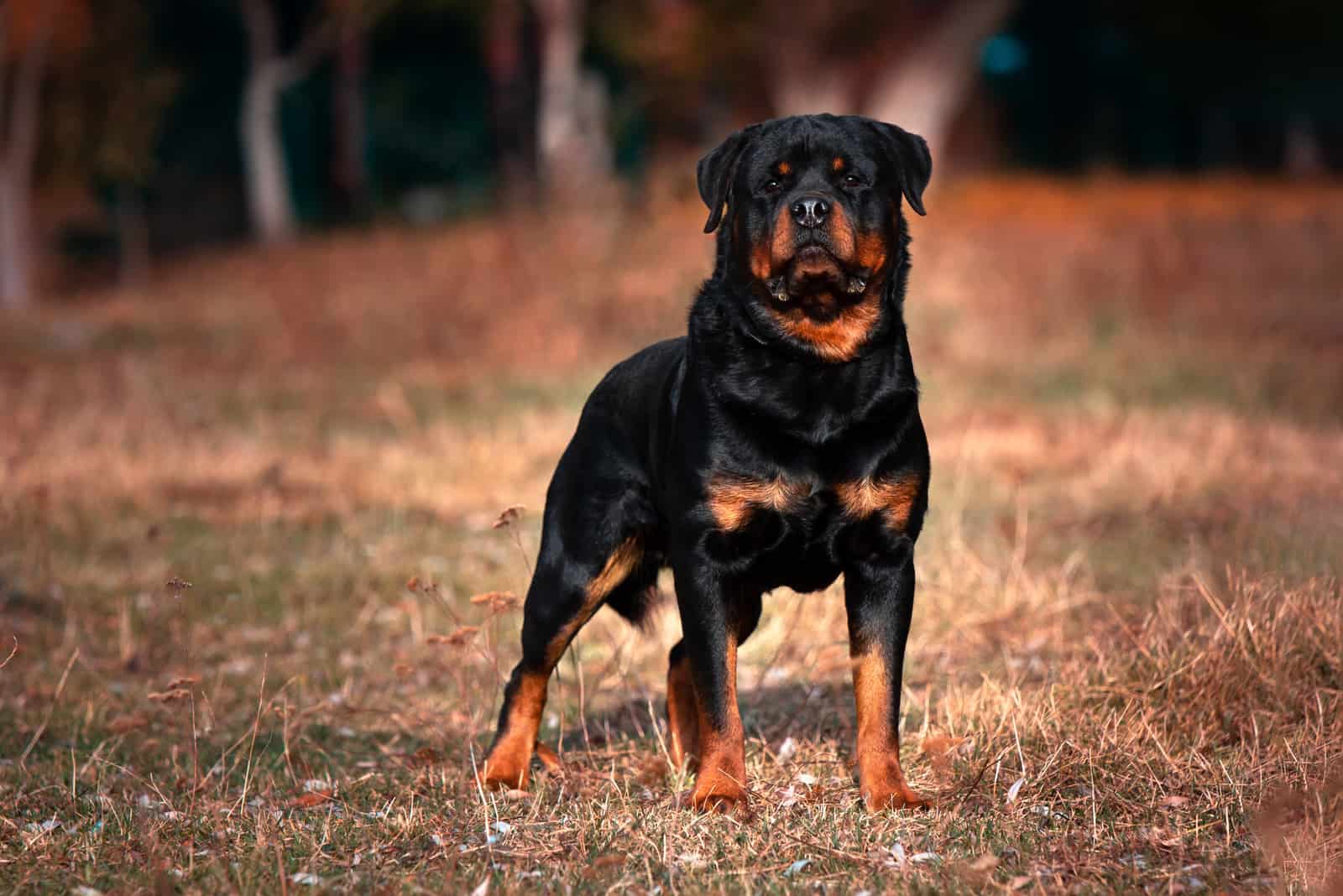
Good-natured, devoted, obedient, and intelligent – it’s not surprising that Rottweilers are such great working dogs. The fact that they’re highly trainable makes them able to perform a great variety of tasks.
They started out herding and guarding cattle, and today, they can be found in all sorts of positions, as guard dogs, guide dogs for the blind, search and rescue dogs, or police dogs.
With the industrialization of the 19th century and the invention of trains, the need for a Rotty’s initial role as a herder dog declined. Nevertheless, they continued to be used for this purpose in certain places of the world.
Their large, robust build and courageous, cautious, and loyal character make the Rottweiler an amazing guard dog. If you do a good job with their training and socialization, they can be extraordinary at protecting you, your family, and your property.
Even though the German Shepherd is the preferred police dog, many countries use Rottweilers for this job. They have been utilized as police dogs since the 19th century, but were officially recognized as such in 1910.
A dog needs to be intelligent, strong, and obedient, with a keen sense of smell and a good hunting instinct in order to enter the police force. A well-trained Rotty checks all those off the list.
These workaholic puppies also make great search and rescue dogs. They bravely did their job, along with other search dogs following the 9/11 terror attacks and in the aftermath of different natural disasters.
Physical similarities and differences
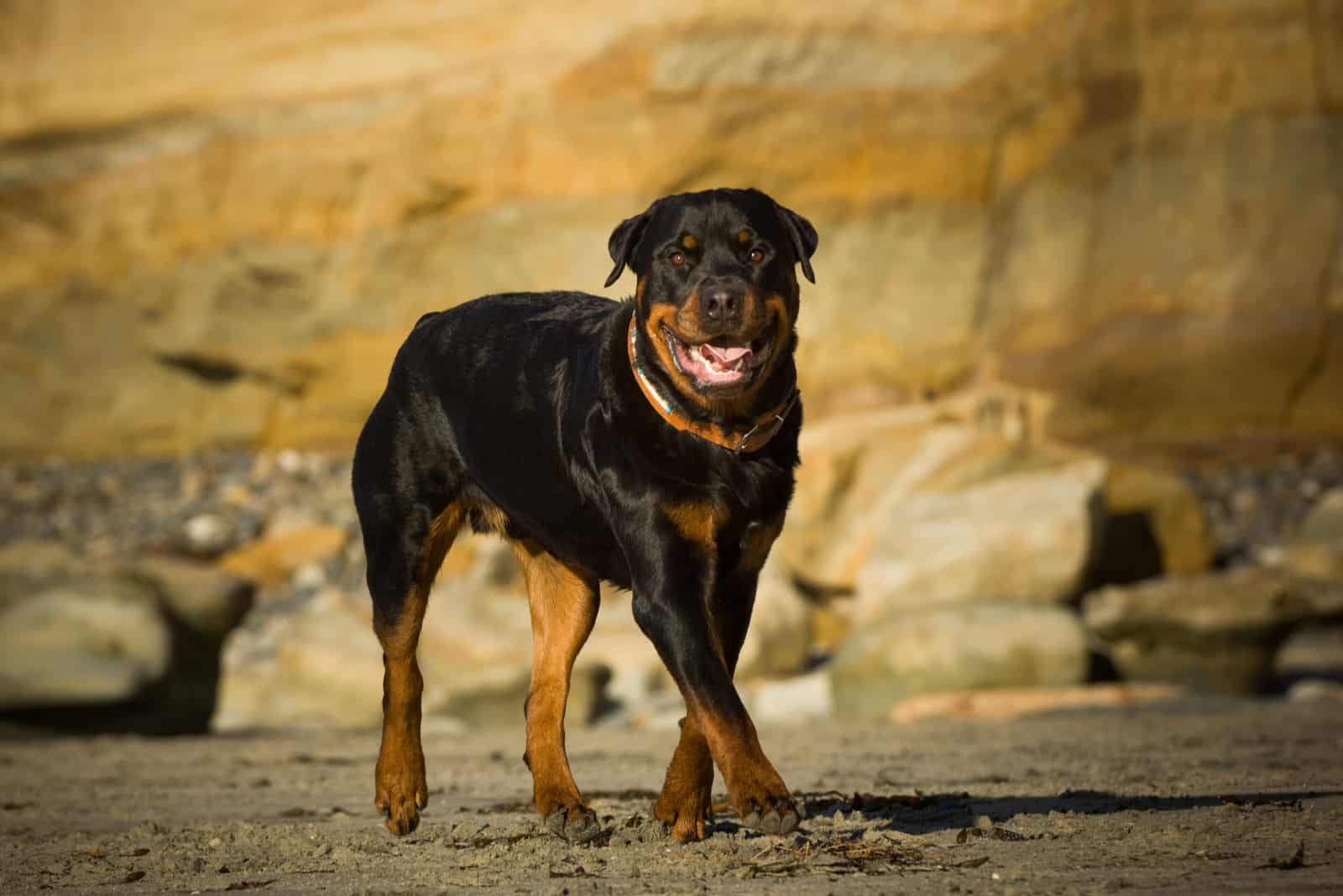
Even an experienced eye would have a hard time telling an American and a German Rottweiler apart.
As it has already been stated, Rottweiler clubs and canine organizations don’t consider them to be separate breeds.
All the more or less noticeable differences between them are simply the outcome of different requirements for registering a Rottweiler as a purebred in these countries.
The Allgemeiner Deutscher Rottweiler-Klub requires a dog’s temperament and physiology to fit the set standard exactly in order to be registered.
Sticking to a stricter set of rules, the ADRK ensures that a Rottweiler’s original appearance and character will be preserved. It also discourages unethical breeding practices and the spreading of puppy mills.
The same can’t be said for the American Kennel Club, whose rules are not as strict. When standards are lowered, the dog’s size, build, colors, and even temperament start to deteriorate over time.
This doesn’t mean that all American Rottweiler breeders are substandard. There are many Code of Ethics breeders that care about the breed and aim to produce high-quality puppies.
So, what does a Rottweiler look like?
If you look up the Rottweiler growth chart, you will see that Rottweilers are medium to large-sized dogs, with males weighing between 95 and 135 pounds, and females weighing between 80 and 100 pounds. Male dogs grow to be 24 to 27 inches in height, while the female’s height varies between 22 and 25 inches.
The size standards are the same in the USA and Germany, with the preferred height being mid-range.
On the other hand, the ADRK sets the correct weight at 110 pounds for male dogs and approximately 92 pounds for females, which is why the German Rotties tend to be slightly larger on average than the American ones.
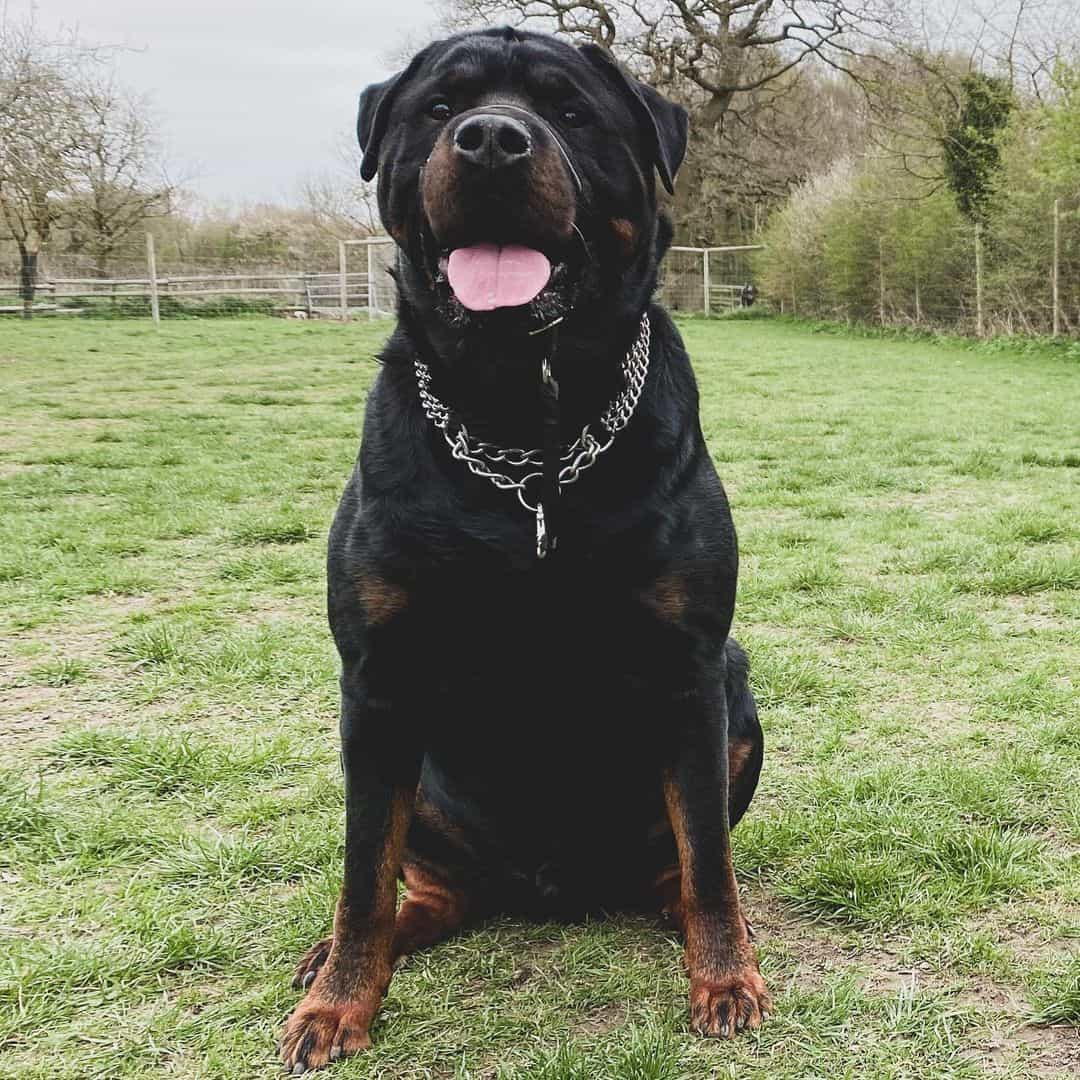
Photo from @_cooperand_max
The AKC calls them ”a robust working breed of great strength”, which is not surprising considering their powerful, muscular build and balanced, confident trotting gait that goes with it.
The average life expectancy for this breed is between nine and ten years.
The Rottweiler’s head is big, standing on a strong, well-muscled, and slightly arched neck free of throatiness. They’ve got well-proportioned muzzles, which are neither too elongated nor too short in relation to their skull.
German Rottweilers usually have bigger heads than their American counterparts, and they’re less likely to have deep wrinkles on the forehead, which is considered a fault.
Their noses are always black and broad, with relatively large nostrils, and their eyes are almond-shaped and dark brown in color. Their ears are medium-sized, triangular, and set on high.
Strong jaws that clasp into a scissor bite can make these doggies seem quite intimidating. German Rotts need to have all of their 42 teeth to pass the Breed Suitability Test or Ztp.
The Zuchttauglichkeitsprufung or the Ztp evaluates the dog’s physical characteristics and personality traits in order to determine whether they are a suitable candidate for a breeding program.
On the other hand, the lack of two or more teeth won’t stop an American Rottweiler from being registered, though it will disqualify them from a show ring.
These double-coated dogs with medium-length, coarse and straight hair of the outer coat are black in color with clearly defined markings on their cheeks, muzzle, throat, chest, legs, above the eyes, and below the tail.
Lack of an undercoat is considered a fault by both the AKC and the ADRK standards.
Three officially recognized marking colors in America are tan, mahogany, and rust, while the ADRK only mentions tan in their breeding standard.
The most obvious difference between a German and an American Rottweiler is the tail. In the USA, Rotts most often have docked tails while their German cousins must have their natural tails as tail-docking and ear-cropping have been banned since 1999.
This is why you won’t see a German Rottweiler with cropped ears.
Tail-docking is the surgical removal of the puppy’s tail for either cosmetic or more justifiable purposes.
Temperament comparison
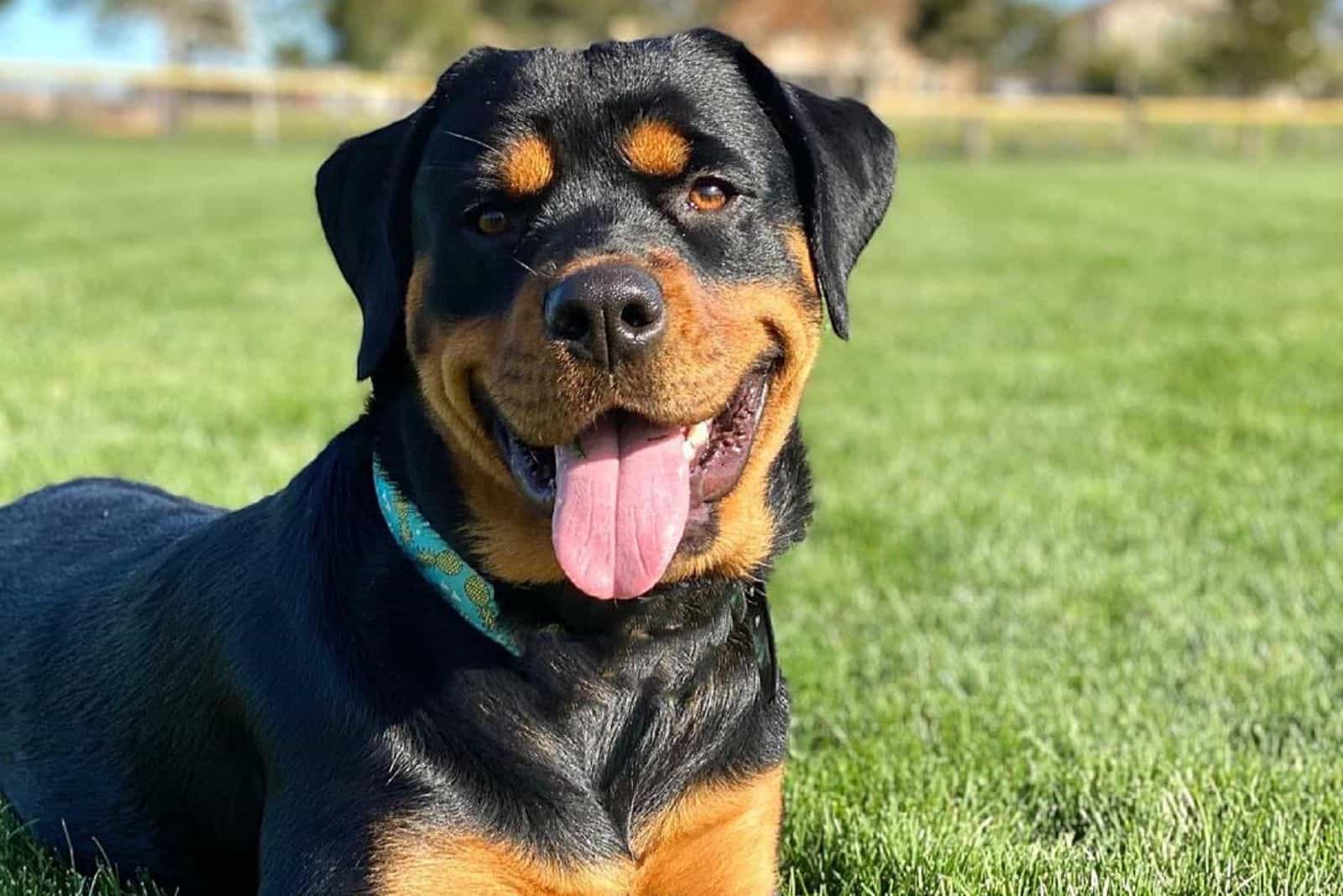
We can safely say that except for their tails and occasionally some minor differences in size, American and German Rottweilers look pretty much the same. But, what about their characters? Are they the same as well?
The American Kennel Club describes the Rottweiler’s temperament as “calm, confident, and courageous, with a self-assured aloofness that does not lend itself to immediate and indiscriminate friendships”.
The ADRK calls them good-natured, very devoted, obedient, and biddable dogs that are eager to work. Their behavior needs to be self-assured, fearless, and always alert with their surroundings.
Germans pay a lot of attention to a dog’s character in order to make sure they’ll be both suitable companions and good at carrying out their tasks.
Any behavioral issues, like aggressiveness, overt shyness, viciousness, or excessive nervousness are considered eliminating faults.
On the other hand, the AKC states that a reserved dog should not be penalized during a conformation show as it’s an accepted character trait for this breed.
Showing aggressiveness towards other dogs should not be considered a fault either; only attacking a person in the ring would call for disqualification.
All the qualities we’ve listed above are to blame for Rottweilers ranking 8th out of 197 breeds in the AKC’s popularity list.
They can be extremely loyal and lovable pets to all those who are willing to make an effort in understanding and taking care of them.
If you’re interested in getting a Rotty, but you feel a bit discouraged by their bad reputation, don’t be too worried.
Whatever aggressive tendencies they might have can be dealt with through proper training and socialization, especially if they’re conducted during puppyhood.
The AKC vs the ADRK Rottweiler breed standard
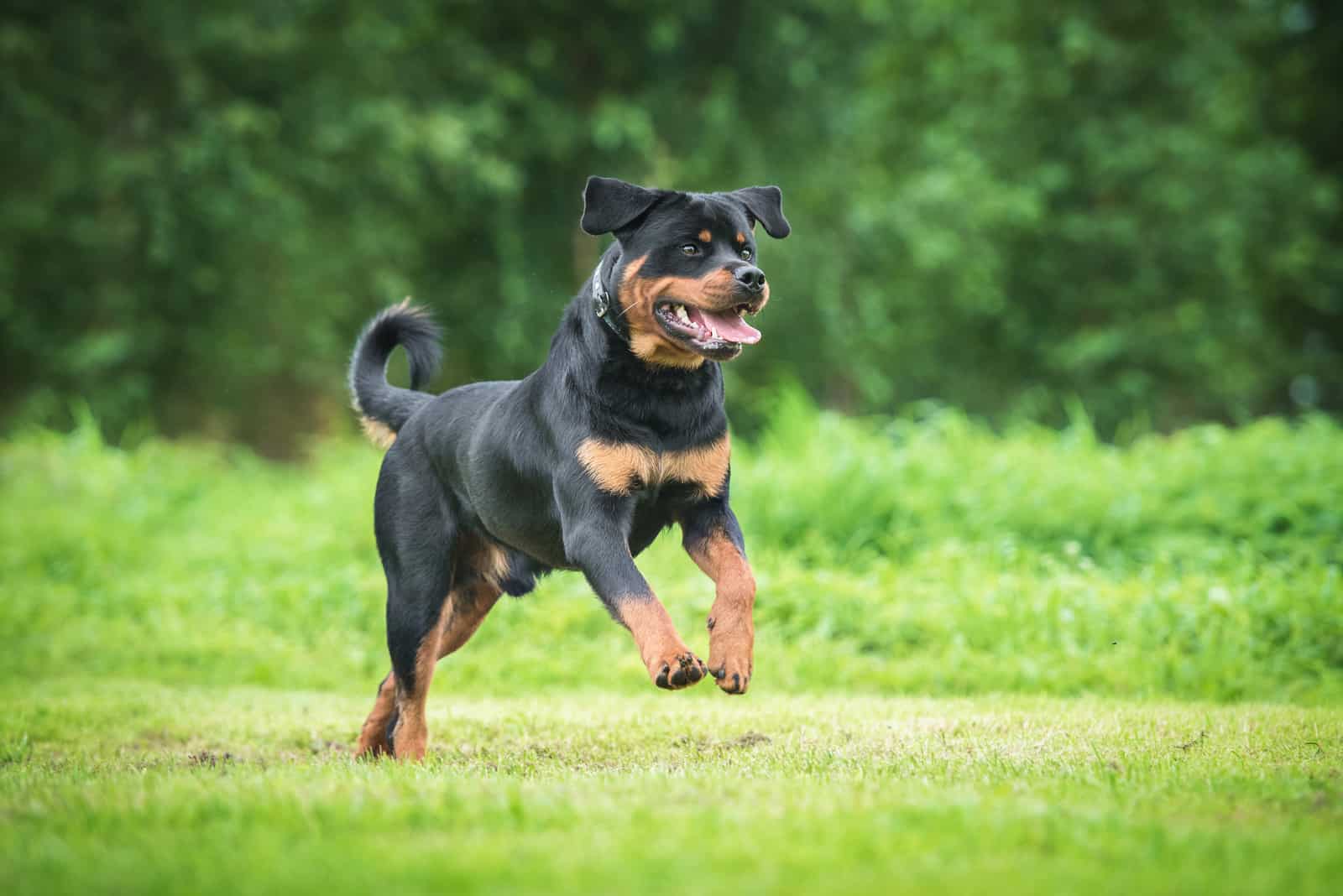
We’ve already determined that the difference between American and German Rottweilers arose from using separate standards to describe the breed.
Some of the required physical and personality traits have been explained so far, but what exactly is keeping some dogs from being accepted as purebreds?
Americans and Germans have a different outlook on what should be considered as faults for these pups. The American Kennel Club has lax rules while the ADRK standard is somewhat stricter.
Faults are undesirable aspects of appearance and temperament that serve as a guideline for responsible breeders, telling them what to strive away from while choosing the parents for their future puppies.
Minor faults can be corrected by careful breeding of the next generation while the major ones can diminish the overall look of the breed over time.
Any physical or behavioral characteristics stated in their standards that don’t fit the detailed description of the ideal Rottweiler are considered as faults by both organizations.
The Germans believe that the seriousness with which the fault should be regarded needs to be in exact proportion to its degree and its effect upon the health and welfare of the dog.
For the AKC, the severity of the fault determines how a dog should be penalized. Their list of eliminating faults includes entropion and ectropion, which are common eye conditions for this breed, as well as unilateral cryptorchid or cryptorchid males.
A dog with an overshot or undershot bite, a wry mouth, or two or more missing teeth would also be disqualified.
Dogs that have long coats, a base color that’s not black, and the absence of markings are also deemed unfit.
According to them, the only behavioral problem that calls for elimination is the dog attacking a person in the ring.
The rules set by the ADRK are more extensive as they’re trying to achieve their goal of preserving the breed as it originally was.
They consider it a severe fault for a dog to resemble the molossoid type too much or to have a heavy general appearance.
A severe fault is also for a dog’s skin to be strongly wrinkled in the areas of the forehead, the muzzle, or the cheeks, and for them to have a strong dewlap.
When it comes to their gait, sluggish action while trotting is seen as unfit for the Rottweiler breed.
Unlike the Americans, the Germans list many undesirable characteristics of temperament as eliminating faults. This shows how seriously they take the task of keeping the breed at a high standard.
Any aggressive, overly shy, anxious, cowardly, excessively suspicious, or nervous dog will be disqualified, as well as any dog clearly showing other behavioral abnormalities.
Alongside the behavioral issues, there are quite a few eliminating physical faults in Germany’s official standard for the breed.
In general appearance, a distinct reversal of sexual types would call for disqualification.
Just like in the USA, dogs with an overshot or undershot bite or a wry mouth would be eliminated. However, in America, a dog would need to lack two or more teeth to be disqualified. Here, the lack of a single incisive tooth, a canine, a premolar, or a molar are considered eliminating faults.
The Allgemeiner Deutscher Rottweiler-Klub puts entropion and ectropion on the list of eliminating faults as well, but they also go a bit further adding yellow or different colored eyes on it.
A long or a wavy coat is not a desired trait either. When it comes to color, dogs not showing the typical black base with tan markings, or dogs with white markings would be eliminated.
Tails are quite important for them. A kinked tail, a ringtail, a natural bobtail, or a tail with strong lateral deviation are all considered eliminating faults.
Health issues
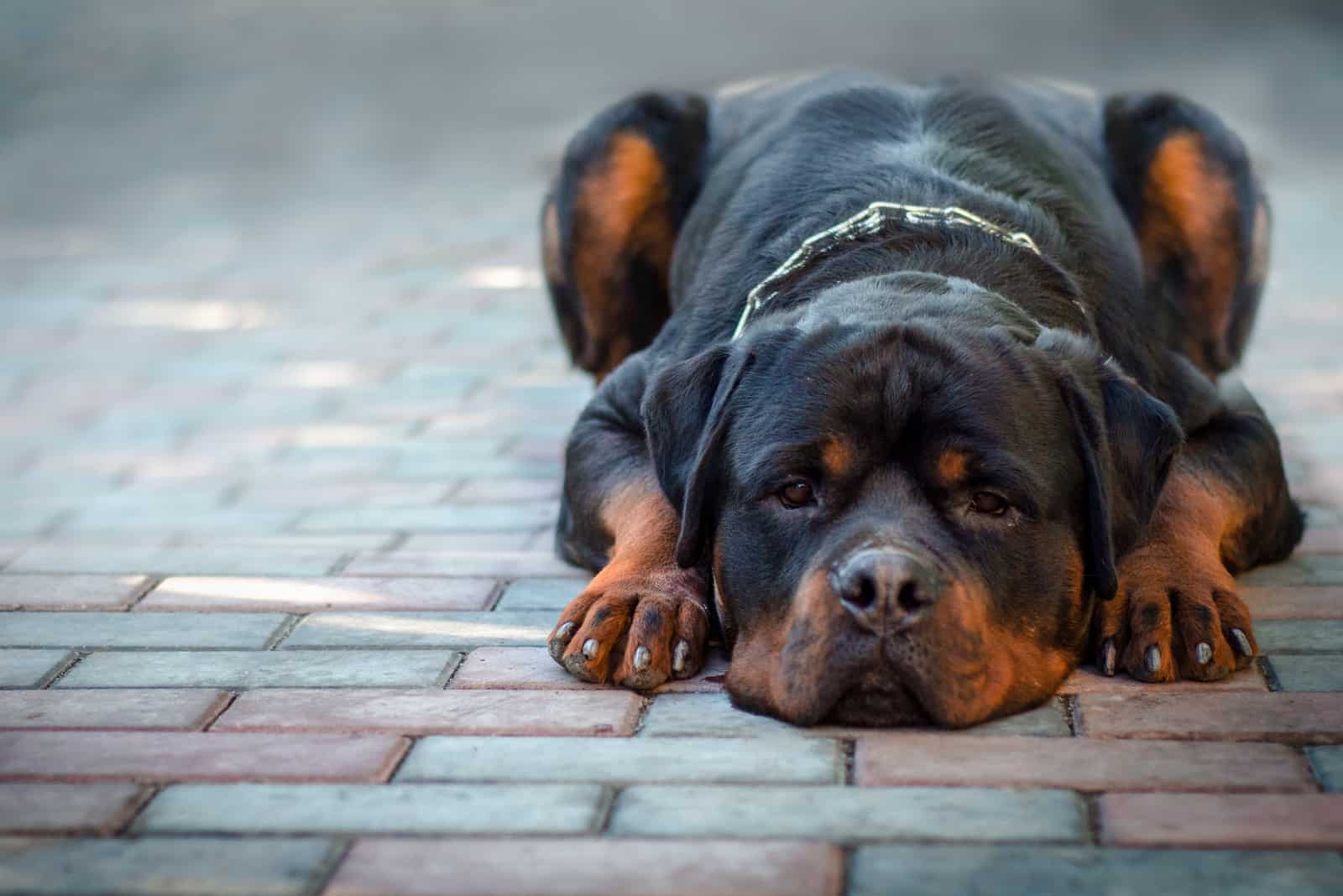
We’ve explained how the German and the American Rotts can differ in terms of appearance and character, but could there also be some differences when it comes to the health issues they might develop?
Since the ADRK considers the overall health of the dog to be of utmost importance, following their breeding standards could lead to producing potentially healthier dogs.
Still, this doesn’t mean they can’t be as prone to certain diseases as their American cousins.
The most common health issues that occur in Rottweilers are:
• Cancer
Many Rottweilers suffer from cancer, and the most common are lymphoma, bone, liver, and spleen cancer. The cause of this is still unknown.
• Aortic Stenosis
Aortic Stenosis is the narrowing of the exit of the heart’s left ventricle. Due to this obstruction, the heart has to work harder to pump blood.
Depending on the degree of narrowing, this condition can range from mild to very serious. Since dogs can pass this to their offspring, breeding is not recommended regardless of the severity.
• Hip Dysplasia
Hip Dysplasia is a common orthopedic disease that affects many medium-sized and large dogs.
It’s an abnormality of the hip joint, which increases the risk of joint dislocation.
The likelihood of the puppies inheriting it from their parents can be predicted by using the hip-scoring system. This system determines individual imperfections on the ball and socket of each hip joint. More imperfections equal more points.
• Elbow Dysplasia
There are several conditions that are referred to as elbow dysplasia and they all affect the elbow joint. It usually affects both front legs of the dog, and it can cause extreme pain, abnormal gait, and immobility.
• Progressive Retinal Atrophy
Progressive Retinal Atrophy is a disease that affects the photoreceptors in the eye. It usually starts with night blindness, and eventually leads to a complete loss of vision.
• Entropion and ectropion
Entropion and ectropion are both inherited conditions that affect the dog’s eyes. Entropion is the inward rolling of the eyelids, and ectropion is the outward rolling of the eyelids. They are both considered to be eliminating faults in all the breed standards.
Should you get yourself a Rottweiler puppy?
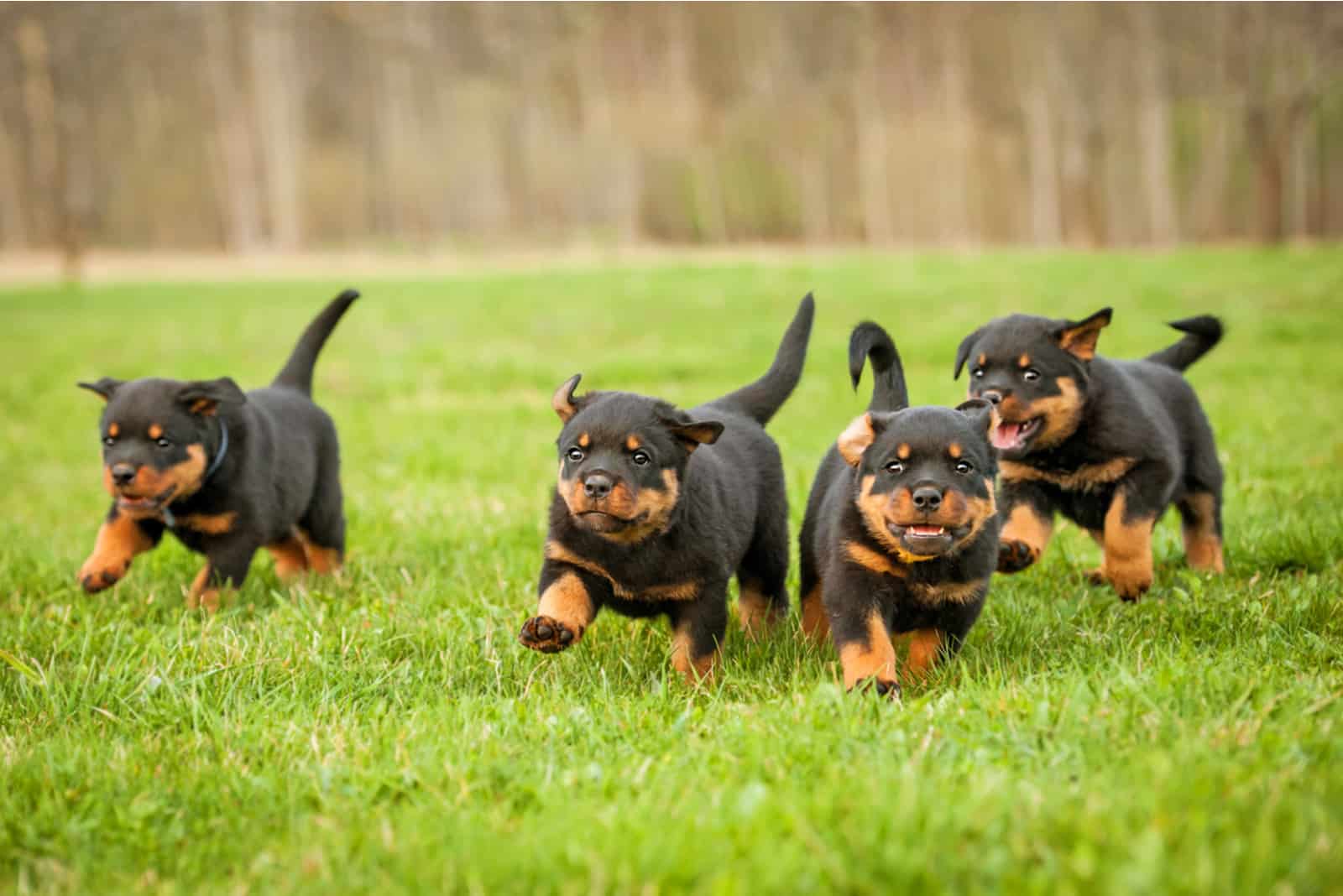
You’ve searched far and wide for the perfect furry companion and you feel a Rottweiler pup might just be the perfect choice for you. Here are some things to keep in mind while choosing the right puppy to take home with you.
Getting a dog from a good breeder might be more expensive, but it will pay off in the long run. Knowing what the puppy’s parents are like will ensure that there won’t be any negative surprises in the future.
Also, this way, you won’t be supporting unethical breeding whose only goal is monetary gain.
There are many Rottweilers in shelters waiting for a forever home, so why not give them a chance?
In case you can’t get a purebred Rottweiler, for any reason, their mixes like those with Cane Corso and Chow Chow are excellent substitutes.
It’s never a dog’s fault for being abandoned. Sometimes, the owners can’t take care of their animals anymore due to different personal reasons, and sometimes, they’re just not able to deal with them.
If you make a place for a dog in your family, they’ll forever be grateful and you’ll feel the full extent of their love.
Rotties can be difficult for first-time dog owners. They tend to be very dominant, so if you’re not sure whether you will be able to assume the alpha role, then maybe they’re still not the right pick for you.
Since they are working dogs, they need a lot of activity and mental stimulation. Ask yourself if your lifestyle can match their needs.
Proper training will keep all the potential behavioral issues at bay. If you do get a Rottweiler puppy, make sure to train and socialize it from a young age.
Training takes a lot of patience and understanding, and it should always be done through positive reinforcement.
However, you should be careful with the treats as they are prone to cause obesity.
These loving, obedient dogs are often seen as being aggressive, which is simply a misconception. Any dog that’s maltreated can become aggressive, but a dog that has been shown love will surely reciprocate it.
Rotts can make awesome family pets that get along great with all their smaller or bigger humans and animal friends.
Read Next: 9 Rottweiler Breeders In Pennsylvania: A Proper Overview
